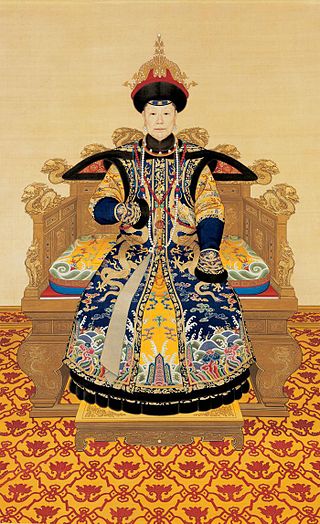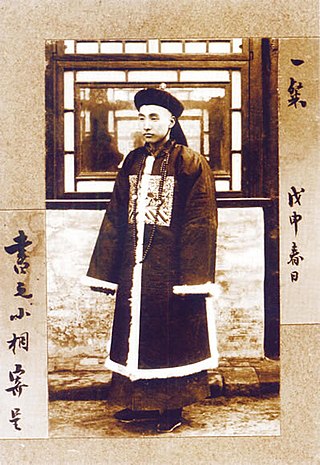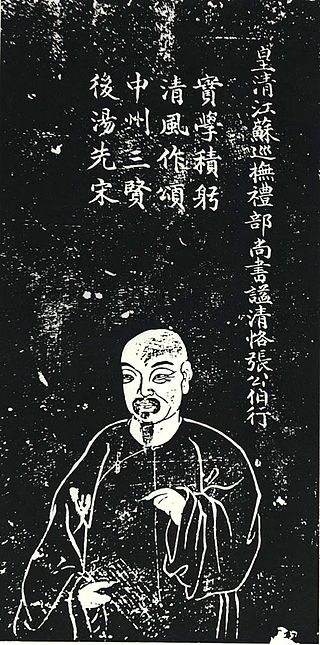
The Qing dynasty, officially the Great Qing, was a Manchu-led imperial dynasty of China and the last imperial dynasty in Chinese history. The dynasty, proclaimed in Shenyang in 1636, seized control of Beijing in 1644, which is considered the start of the dynasty's rule. The dynasty lasted until 1912, when it was overthrown in the Xinhai Revolution. In Chinese historiography, the Qing dynasty was preceded by the Ming dynasty and succeeded by the Republic of China. The multi-ethnic Qing dynasty assembled the territorial base for modern China. It was the largest imperial dynasty in the history of China and in 1790 the fourth-largest empire in world history in terms of territorial size. With over 426 million citizens in 1907, it was the most populous country in the world at the time.

The Qianlong Emperor, also known by his temple name Emperor Gaozong of Qing, personal name Hongli, was the sixth emperor of the Qing dynasty and the fourth Qing emperor to rule over China proper. He reigned officially from 1735 until his abdication in 1796, but retained ultimate power subsequently until his death in 1799, making him one of the longest-reigning monarchs in history as well as one of the longest-lived.

The Yongzheng Emperor, also known by his temple name Emperor Shizong of Qing, personal name Yinzhen, was the fifth emperor of the Qing dynasty, and the third Qing emperor to rule over China proper.

The Revolt of the Three Feudatories, also known as the Rebellion of Wu Sangui, was a rebellion lasting from 1673 to 1681 in early Qing dynasty of China, during the early reign of the Kangxi Emperor. The revolt was led by Wu Sangui, Shang Zhixin and Geng Jingzhong, the three Han Chinese lords of Yunnan, Guangdong and Fujian provinces whose hereditary titles were given for defecting and helping the Manchus conquer China, who rebelled after the Qing central government started removing their fiefdoms. The feudatories were supported by Zheng Jing's Kingdom of Tungning in Taiwan, which sent forces to invade Mainland China. Additionally, minor Han military figures, such as Wang Fuchen and the Chahar Mongols, also revolted against Qing rule.

Zhang Tingyu was a Han Chinese politician and historian who lived in the Qing dynasty.

Empress Xiaoshengxian, of the Manchu Bordered Yellow Banner Niohuru clan, was a posthumous name bestowed to the consort of Yinzhen, the Yongzheng Emperor and mother of Hongli, the Qianlong Emperor. She was honoured as Empress Dowager Chongqing during the reign of her son and posthumously honoured as empress, although she never held the rank of empress consort during her lifetime.

Imperial Noble Consort Huixian, of the Manchu Bordered Yellow Banner Gaogiya clan, was a consort of the Qianlong Emperor.

The Viceroy of Sichuan, fully in Chinese as the Governor-General of Sichuan and Other Local Areas, in Charge of Military Affairs, Food and Wages and Governor Affairs, was one of eight regional Viceroys during the Qing dynasty. The Viceroy of Sichuan had jurisdiction of military, civil, and political affairs over then Sichuan Province.
The Miao Rebellion of 1735–1736 was an uprising of autochthonous people from southwest China.
The history of the Qing dynasty began in the first half of the 17th century, when the Qing dynasty was established and became the last imperial dynasty of China, succeeding the Ming dynasty (1368–1644). The Manchu leader Hong Taiji renamed the Later Jin established by his father Nurhaci to "Great Qing" in 1636, sometimes referred to as the Predynastic Qing in historiography. By 1644 the Shunzhi Emperor and his prince regent seized control of the Ming capital Beijing, and the year 1644 is generally considered the start of the dynasty's rule. The Qing dynasty lasted until 1912, when Puyi abdicated the throne in response to the 1911 Revolution. As the final imperial dynasty in Chinese history, the Qing dynasty reached heights of power unlike any of the Chinese dynasties which preceded it, engaging in large-scale territorial expansion which ended with embarrassing defeat and humiliation to the foreign powers whom they believe to be inferior to them. The Qing dynasty's inability to successfully counter Western and Japanese imperialism ultimately led to its downfall, and the instability which emerged in China during the final years of the dynasty ultimately paved the way for the Warlord Era.

Yu Minzhong was an official of the Qing Dynasty, who served as chief grand councilor for part of the reign of the Qianlong Emperor. Yu Minzhong was a native of Jintan, Jiangsu province. In 1737, he became a Zhuangyuan of the Imperial examination. Before his appointment as chief grand councilor, he served as an editor and scribe to the emperor. During his tenure as chief grand councilor, a significant rise in corruption occurred.
Fang Bao, courtesy names Fengjiu (鳳九), Linggao (靈皋), and Wangxi (望溪), was a Chinese nobleman, courtier, orator, philosopher, poet, scholar, author and government official of the Qing dynasty. He is best known as a founder of the Tongcheng school of literary prose which was influential during the mid-Qing dynasty.

The Jinchuan campaigns, also known as the Suppression of the Jinchuan Hill Peoples, were two wars between Qing Empire and the rebel forces of Gyalrong chieftains ("Tusi") from the Jinchuan region. The first campaign against Chiefdom of Chuchen happened in 1747 when the Tusi of Greater Jinchuan Slob Dpon attacked the Chiefdom of Chakla (Mingzheng). The Qianlong Emperor decided to mobilize forces and suppress Slob Dpon, who surrendered to the central government in 1749. The second campaign against Chiefdom of Tsanlha took place in 1771, when the Jinchuan Tusi Sonom killed Geshitsa Tusi of Ngawa County in Sichuan Province. After Sonom killed Geshitsa Tusi, he helped Tusi of Lesser Jinchuan, Skal bzang, to occupy the lands belonging to the other Tusi in the region. The provincial government ordered Sonom to return lands and accept the trial at the Ministry of Justice immediately. Sonom refused to retreat his rebels. The Qianlong Emperor was furious and gathered 80,000 troops and entered Jinchuan. In 1776, Qing troops sieged the castle of Sonom to force his surrender.
Liu Tongxun was a politician in Qing dynasty. He was one of relatively few ethnically Han Grand Secretariat of the Qianlong Emperor's reign. He has served for the Qing government for more than 40 years with integrity, and dares to direct advice to the emperor, has made remarkable achievements in official administration, military affairs and river conservancy.
Events from the year 1674 in China.
Sirin Gioro was a clan of the Manchu nobility, one of the prominent Gioro family. The other clans of Gioro Hala were Aisin Gioro, the ruling clan from 1616 to 1912, Irgen Gioro and Šušu Gioro. The clan belonged to the Bordered Blue Banner. The clan members inhabited the area ranging from Nimaca, Hoifa, Changbai Mountains, Jianzhou, Ningguta and Hada.

The Qing dynasty (1644–1912) was the last imperial dynasty of China. The early Qing emperors adopted the bureaucratic structures and institutions from the preceding Ming dynasty but split rule between the Han and Manchus with some positions also given to Mongols. Like previous dynasties, the Qing recruited officials via the imperial examination system until the system was abolished in 1905. The Qing divided the positions into civil and military positions, each having nine grades or ranks, each subdivided into a and b categories. Civil appointments ranged from an attendant to the emperor or a grand secretary in the Forbidden City (highest) to being a prefectural tax collector, deputy jail warden, deputy police commissioner, or tax examiner. Military appointments ranged from being a field marshal or chamberlain of the imperial bodyguard to a third class sergeant, corporal or a first or second class private.
He Tengjiao, courtesy name Yuncong, was a military officer of the late Ming dynasty who led rebellions against the Qing dynasty. He was from Liping, Guizhou.

Zhang Boxing was a Han Chinese politician and scholar in the Qing dynasty.












